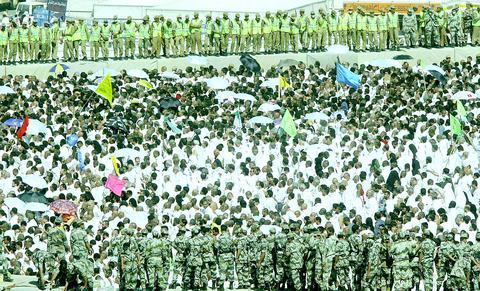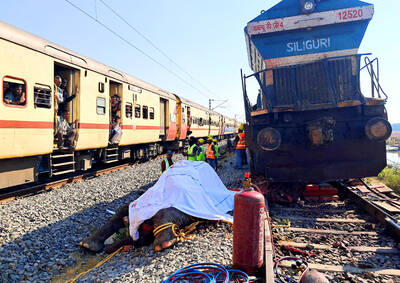King Fahd of Saudi Arabia ordered the holy places of Mecca and Medina to be modernized hours after 244 Muslims -- half of them Asians -- died during a ritual that regularly results in deadly stampedes at the hajj pilgrimage.
The 20-year project, announced by royal decree, would be drawn up by ministers and senior regime officials who would "gradually put forward proposals" and could call on expertise from abroad as well as within the kingdom, the official Saudi Press Agency said.
The 244 dead and a similar number injured were trampled or suffocated as a huge crush started Sunday when vast numbers of pilgrims surged forward to lob stones at pillars representing the devil.

PHOTO: EPA
The ritual involving up to 1.9 million white-robed pilgrims was due to continue in the valley of Mina, just outside Mecca, for the second day, starting around midday.
It promised to be a further high-risk exercise for the Saudi authorities who had nonetheless announced last month an "integrated crowd control strategy" to prevent new tragedies during the annual event.
Pilgrims were to be dispatched in groups for the rite at a huge two-tier bridge, limitations imposed on the numbers heading toward the area and special forces deployed immediately to disperse people in case of a stampede.
The faithful were also to be told to leave the area quickly after completing the ritual while arrangements had been made to rescue pilgrims who faint or become trapped due to overcrowding. The movement of pilgrims was also to be monitored via closed-circuit television.
Last year 14 pilgrims were killed in a stampede during the first day of the same ritual and 35 in 2001, while the 1998 hajj saw 118 killed and more than 180 hurt at the pillars.
Asians bore the brunt of the latest disaster with 54 Indonesians and 36 Pakistanis among the dead, the Saudi interior ministry said.
"We believe that most of the dead are from among illegal pilgrims," Hajj Minister Madani said, referring to those who arrived earlier in the year to perform the minor umrah pilgrimage and stayed illegally, as well as local residents who never registered for the hajj.
He said 2,000 national guard members were moved to the area following the stampede to reinforce 10,000 police already on site.
Despite the stampede, which lasted nearly half an hour, the ritual resumed later Sunday and continued for two and a half hours.
To cries of "Allahu Akbar," pilgrims hurl seven small stones from behind a fence or from the overhead bridge every day for three days at each of the three 18m-high concrete pillars that symbolize Satan.
The pillars stand only 155m apart.
They are generally mobbed as the pilgrims try to get close despite the beefed-up security measures.
According to tradition, Satan appeared on the same site to the Prophet Abraham, his son Ismael and wife Hagar.
Each threw seven stones at the devil.
Pilgrims who were at the rite on Sunday gave varying accounts of what took place but all said they would not be deterred.
"I was there and saw 30 to 40 bodies on the ground. But I don't know if they were dead or unconscious," said one young Saudi who declined to give his name.
"What happened this morning did not stop the accomplishing of the hajj rituals. The pilgrims continued to rush in," added Waleed Faydullah, a 32-year-old Egyptian.
The first two days of the pilgrimage had passed without incident -- although authorities said they arrested in Riyadh on Thursday seven suspected members of a "terror group" planning an attack.
The worst toll of the pilgrimage was in July 1990, when 1,426 pilgrims were trampled or asphyxiated to death in a tunnel in Mina.

The Burmese junta has said that detained former leader Aung San Suu Kyi is “in good health,” a day after her son said he has received little information about the 80-year-old’s condition and fears she could die without him knowing. In an interview in Tokyo earlier this week, Kim Aris said he had not heard from his mother in years and believes she is being held incommunicado in the capital, Naypyidaw. Aung San Suu Kyi, a Nobel Peace Prize laureate, was detained after a 2021 military coup that ousted her elected civilian government and sparked a civil war. She is serving a

REVENGE: Trump said he had the support of the Syrian government for the strikes, which took place in response to an Islamic State attack on US soldiers last week The US launched large-scale airstrikes on more than 70 targets across Syria, the Pentagon said on Friday, fulfilling US President Donald Trump’s vow to strike back after the killing of two US soldiers. “This is not the beginning of a war — it is a declaration of vengeance,” US Secretary of Defense Pete Hegseth wrote on social media. “Today, we hunted and we killed our enemies. Lots of them. And we will continue.” The US Central Command said that fighter jets, attack helicopters and artillery targeted ISIS infrastructure and weapon sites. “All terrorists who are evil enough to attack Americans are hereby warned

Seven wild Asiatic elephants were killed and a calf was injured when a high-speed passenger train collided with a herd crossing the tracks in India’s northeastern state of Assam early yesterday, local authorities said. The train driver spotted the herd of about 100 elephants and used the emergency brakes, but the train still hit some of the animals, Indian Railways spokesman Kapinjal Kishore Sharma told reporters. Five train coaches and the engine derailed following the impact, but there were no human casualties, Sharma said. Veterinarians carried out autopsies on the dead elephants, which were to be buried later in the day. The accident site

‘EAST SHIELD’: State-run Belma said it would produce up to 6 million mines to lay along Poland’s 800km eastern border, and sell excess to nations bordering Russia and Belarus Poland has decided to start producing anti-personnel mines for the first time since the Cold War, and plans to deploy them along its eastern border and might export them to Ukraine, the deputy defense minister said. Joining a broader regional shift that has seen almost all European countries bordering Russia, with the exception of Norway, announce plans to quit the global treaty banning such weapons, Poland wants to use anti-personnel mines to beef up its borders with Belarus and Russia. “We are interested in large quantities as soon as possible,” Deputy Minister of National Defense Pawel Zalewski said. The mines would be part